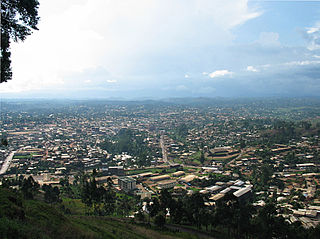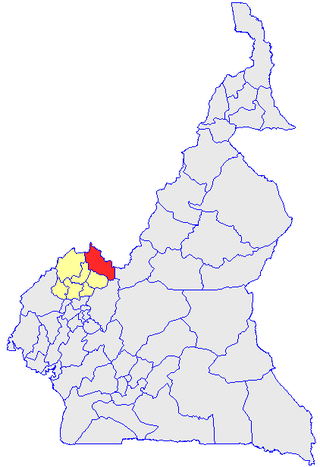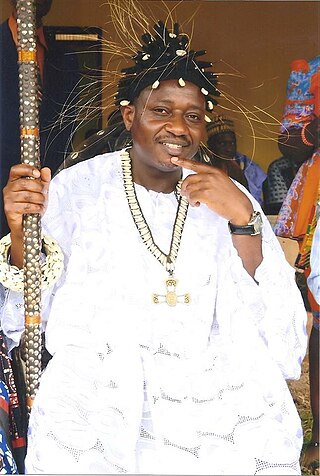
An ecovillage is a traditional or intentional community with the goal of becoming more socially, culturally, economically, and/or ecologically sustainable. An ecovillage strives to produce the least possible negative impact on the natural environment through intentional physical design and resident behavior choices. It is consciously designed through locally owned, participatory processes to regenerate and restore its social and natural environments. Most range from a population of 50 to 250 individuals, although some are smaller, and traditional ecovillages are often much larger. Larger ecovillages often exist as networks of smaller sub-communities. Some ecovillages have grown through like-minded individuals, families, or other small groups—who are not members, at least at the outset—settling on the ecovillage's periphery and participating de facto in the community. There are currently more than 10,000 ecovillages around the world.

Bamenda, also known as Abakwa and Mankon Town, is a city in northwestern Cameroon and capital of the Northwest Region. The city has a population of about 2 million people and is located 366 km (227 mi) north-west of the Cameroonian capital, Yaoundé. Bamenda is known for its cool climate and scenic hilly location.
Articles related to Cameroon include:

Mankon is a geo-historic community constituting a large part of Bamenda in Cameroon, formed as an amalgamation of about five different ethnic groups. The Mankon fondom (kingdom) represents one of the oldest monarchies of the grassfield people of the Northwest Province. The fondom is ruled by a fon (king) with rights to kinghood acquired by birth. The crowned fon is usually a designated son of the deceased king, a child who was born only during his reign.
The Fon of Bafut is the fon or Mfor of the town of Bafut and its adjoining areas in the Northwest Province, Cameroon, which comprise the erstwhile Fondom of Bafut. At present, the Fon of Bafut is still a local ruler, but under the jurisdiction of the Government of Cameroon, and a board of Fons. Bafut is one of the largest villages in the North West Province.
The Bafut Wars were a series of wars fought in the early 20th century between the troops of the Fon of Bafut and German-backed troops of neighbouring fondoms and German troops. The wars ultimately led to a defeat for the Fon of Bafut, forcing him into exile, and making the Fondom of Bafut part of the German protectorate of Kamerun.

A Fon is a chieftain or king of a region of Cameroon, especially among the Ngie, Widikum, Tikar, and Bamiléké peoples of the Bamenda grass fields and the Lebialem of the South West Region. Following the defeat of Germany in World War I, the Fons of British Cameroon came under British rule, and the Fons of French Cameroon came under French rule. Since Cameroon's independence in 1961, the Fons are under the jurisdiction of the Government of Cameroon. However, they maintain semi-autonomous union councils and jurisdiction over their hereditary land.
The Fondom of Bafut political system centred on the Fon or Mfor who was the fount of the political and religious life of the people.
Founded in 1800, the Kom are one of the 250 ethnic groups that are located in the grasslands of Cameroon within the Boyo Division of Africa. Kom includes most of Boyo division, including such towns as Fundong, Belo, Njinikom and Mbingo. The area can be reached from Bamenda on the so-called Ring Road.
The Nso people are from the Bamenda grass fields Northwest Region of Cameroon. Their traditional language is Lamnso and their capital is Kumbo – where the Palace of the Fon is found.
Bambui is an emerging township in northwestern Cameroon. With a population of about 35,000 people, it is located at an elevation of about 1350 metres above sea level. Administratively, Bambui is the headquarters of Tubah Sub-Division in the North West Region of Cameroon. Popularly known to its inhabitants as “abeh-mbeuh,” Bambui is one of the Bamenda grassfield communities of Cameroon, and is known for its mix of modern and indigenous African life. With its lush, rolling, and fertile plains, a mild tropical climate, and an extremely industrious farming community, Bambui is the bread basket of the North West Region in particular and of Cameroon in general. Lying snug in the immense arms of the Sabga hill, Bambui is situated between Sabga and the undulating foothills that separate it with its neighbors, virtually in the shape of a bowl. Bambui is located at the cross-roads that lead to some of the North West Region's major towns of Bamenda, Ndop, Kumbo, Fundong and Nkambé.
The Bafut Subdivision or the Kingdom/Chiefdom/Fondom of Bafut is a commune in the Mezam Department of Northwest Province, Cameroon. It is located in the Western Grassfields region - a name for the Northwest Province and surrounding grassland areas. Bafut is the most powerful of the traditional kingdoms of the Grassfields, now divided into 26 wards along a 10 kilometre stretch of the "Ring Road" that trails along a ridge above the Menchum Valley.

Fon R.A.M. Tebo II of Batibo ascended the throne upon the death of his father HRH G.T.T. Mba II in 2005 amidst great political, cultural and economic anxiety in the Batibo Fondom.

Donga-Mantung (Mantungia) is a division of the Northwest Region of Cameroon. The division covers an area of 4279 km2 and as of 2001 had a total population of 337,533. The capital city of the division is Nkambe.

Menchum is a department of Northwest Province in Cameroon. The department covers an area of 4469 km2 and as of 2005 had a total population of 161,998. The capital of the department lies at Wum. The Menchum River drains this area, flowing westward into Nigeria to join the Benue River.
The Widikum people are an ethnic group of Cameroon and are one of the largest ethnic groups of the North-West Region of Cameroon.

Guneku is one of the villages in Momo Division located in the Northwest region of Cameroon, Central Africa. It has a tropical climate with 2 main seasons; the rainy and dry seasons with a population of approximately 15 000 inhabitants. The main occupations of the inhabitants are subsistence farming, and cattle rearing. Guneku has a lot of touristic sites such as the palace, caves, mountains, waterfalls, hills and valleys, rivers and springs. Guneku is one of the 31 communities that make up the Meta clan sharing boundaries with Mbemi, Nyen, Tugi, Zang-Tembeng, Oshie, Mundum and Bafut. The Bantous and Mbororos are the two tribes that cohabit peacefully in the community.

Balikumbat is a village located in Balikumbat Sub Division, Ngoketunjia Division of the North West Region, Cameroon. Balikumbat is the Sub Divisional Headquarter of Balikumbat Sub Division and located about 20.9 km from Ndop town.

Operation Free Bafut was a week-long Cameroonian military operation against the Seven Karta militia in and around Bafut that resulted in the deaths of two separatist generals.

Bafutpeople, also known as Fut or Bufu people are a Grassfields ethnic group located in the Bafut Subdivision of the North West Province, Cameroon.
























